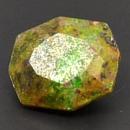|
|
||||||||||||||||
|
||||||||||||||||
|
||||||
|
|
|
|
Cuprosklodowskite
|
|
| | |
| Discovered in 1933; IMA status: Valid (pre-IMA; Grandfathered) | ||
|
| ||
|
Chemistry |
|
|
| |
|
Cu(UO2)2(SiO4)2(H4O)2 • 2(H2O) | |
|
|
Hydrated Copper Uranyl Silicate |
|
Molecular Weight: |
861.84 gm |
|
Composition: |
Uranium |
55.24 % |
U |
62.66 % |
UO2 |
|
|
Copper |
7.37 % |
Cu |
9.23 % |
CuO |
|
|
Silicon |
6.52 % |
Si |
13.94 % |
SiO2 |
|
|
Hydrogen |
1.17 % |
H |
10.45 % |
H2O |
|
|
Oxygen |
29.70 % |
O |
|
|
|
|
|
100.00 % |
|
96.29 % |
= TOTAL OXIDE |
|
|
|
||||
|
Classification |
|
|
| |
|
SILICATES (Germanates) | |
|
8/B.34-20 | |
|
|
9 : SILICATES (Germanates)
|
|
Related to: |
n/a |
|
Varieties: |
None |
|
Synonyms: |
Cuprosklodovskite, ICSD 4350, Jachimovite, Jachymovite, Jachymovite (of Novácek), PDF 19-413 |
|
|
|
|
Crystal Data |
|
|
|
|
|
As needles, to 3 cm, commonly somewhat flattened on {010} and elongated along [100]. In radiating groups of crystals, matted fibers, and thin crusts. |
|
|
None |
|
|
|
|
|
Physical Properties |
|
|
|
|
|
Distinct/good on {100} |
|
|
Conchoidal |
|
|
Brittle |
|
|
4.0 |
|
|
3.85 (g/cm3) |
|
|
None |
|
|
Very Strong; GRapi = 4,140,994.92 (Gamma Ray American Petroleum Institute Units) |
|
|
Health Warning: |
Contains uranium - always wash hands after handling. Avoid inhaling dust when handling or breaking. Never lick or ingest. Avoid prolonged exposure in proximity of the body. Store away from inhabited areas. |
|
|
|
|
Optical Properties |
|
|
|
|
|
Yellowish green to grass-green or greenish yellow |
|
|
Transparent, translucent |
|
|
Dull to silky in aggregates |
|
|
1.654 - 1.667 Biaxial ( - ) |
|
|
0.010 - 0.012 |
|
|
r > v |
|
|
Visible; X = nearly colorless; Y = Z = yellowish green |
|
|
|
|
|
Occurances |
|
|
|
|
|
Geological Setting: |
A secondary mineral formed by alteration of earlier uranium minerals, both in situ and after transport of solutions. |
|
Common Associations: |
Becquerelite, Brochantite, Uranophane, Kasolite, Vandenbrandeite, Liebigite, Uranophane-beta, Compreignacite. |
|
Common Impurities: |
n/a |
|
Type Locality: |
Kalongwe deposit, Katanga (Shaba), Democratic Republic of Congo (Zaïre) |
|
Year Discovered: |
1933 |
|
View mineral photos: | |
|
|
|
|
More Information |
|
|
|
|
|
| |
|
|
|
|
Cuprosklodowskite was named by Henri Buttgenbach, a famous Belgian metallurgist, while introducing Johannes Franciscus Vaes' paper, in the mistaken belief that the new mineral was the copper analog of Sklodowskite. Sklodowskite was named after Marie Sklodowska-Curie (1867-1934) who, with her husband Pierre Curie, was a pioneer in the study of radioactivity. As with all radioactive minerals always wash hands after handling. Avoid inhaling dust when handling or breaking. Never lick or ingest. Avoid prolonged exposure in proximity of the body. Store away from inhabited areas. Locations
for Cuprosklodowskite: In Congo (Zaire), from Katanga
(Shaba) Province, at Kambove and Kalongwe deposit [TL],
with exceptional specimens from Shinkolobwe and the
Musonoi mine, Kolwezi. From Jáchymov (Joachimsthal),
Czech Republic. At Johanngeorgenstadt, Saxony, Germany.
From West Wheal Owles and the Geevor mine, St. Just,
Cornwall, England. In the Rabéjac uranium deposit,
seven km south-southwest of Lodève, Hérault,
France. In the USA, in New Mexico, from the Sanostee
area, San Juan County, in the Woodrow mine, Laguna district,
Valencia County, and in the Grants district, McKinley
County; in Utah, in the Frey No. 4 mine, Frey Canyon,
the Posey mine, Red Canyon, and the Happy Jack mine,
White Canyon, San Juan County; in California, on the
Ram claims, Pinto Mountains, Riverside County. In Canada,
from the Nicholson mine, Lake Athabasca, Saskatchewan.
At Kenzan, Okayama Prefecture, Japan. |
|
|
We
have not photographed our Cuprosklodowskite
gems. Please
check back soon. |
